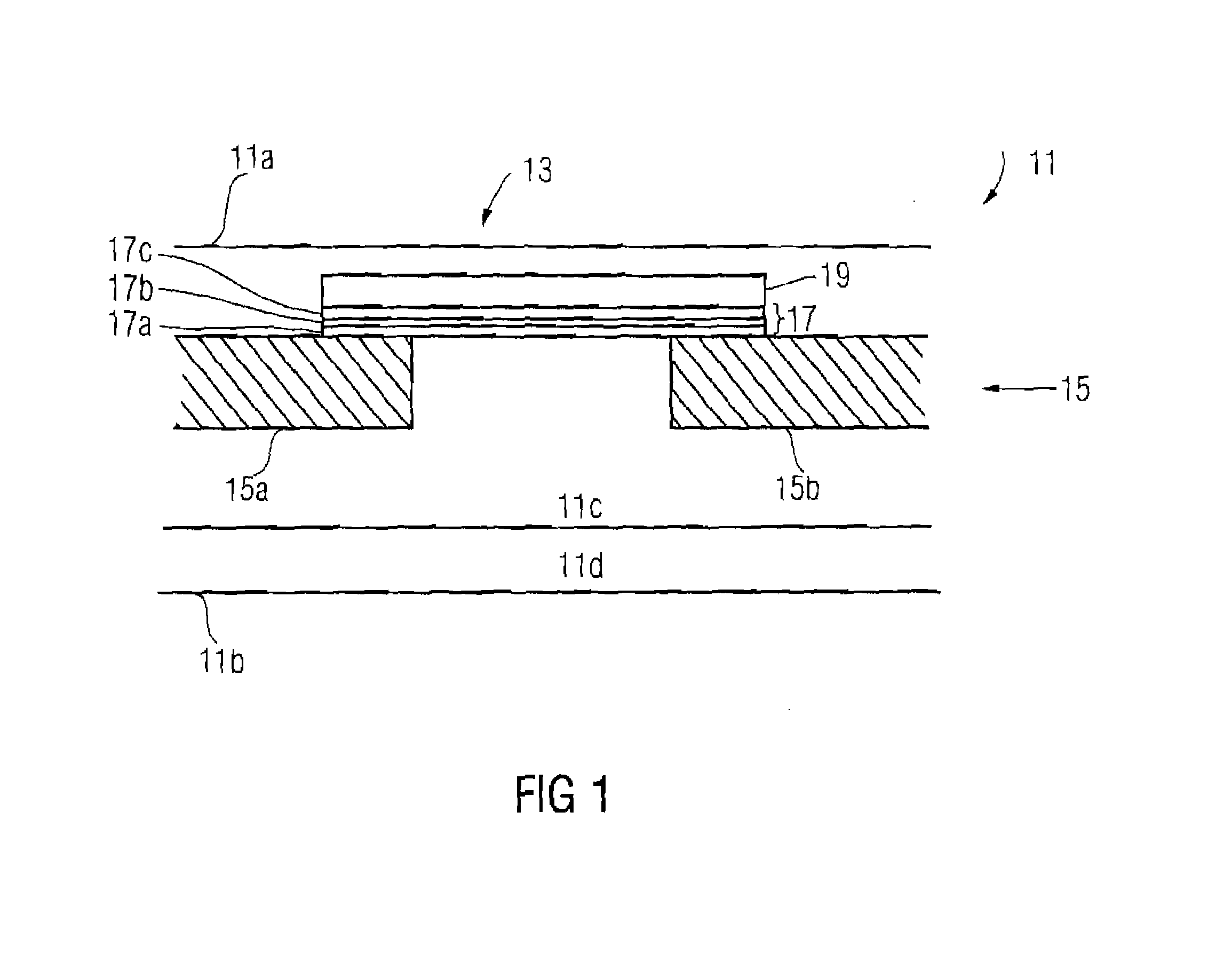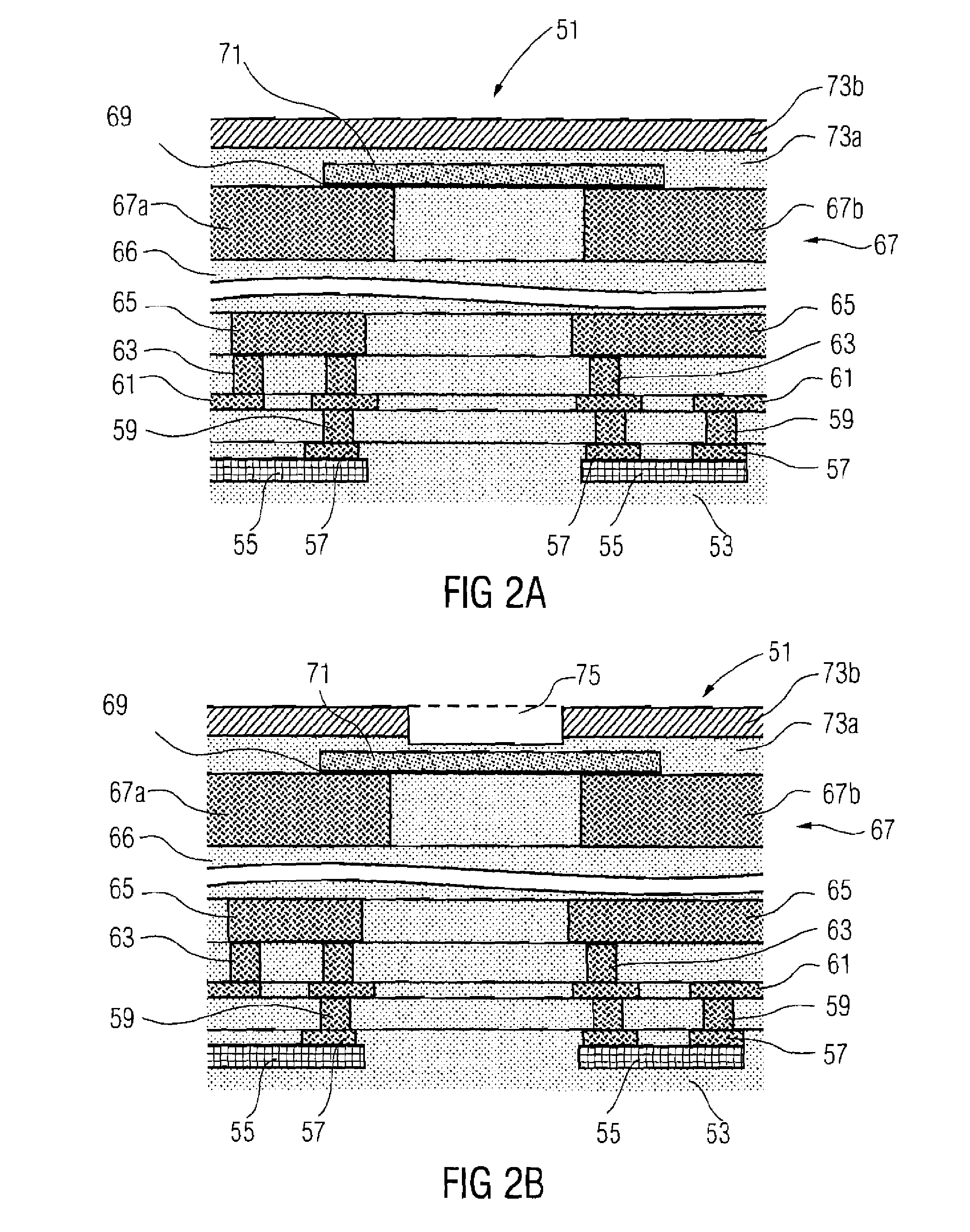Fuse Structure and Method for Manufacturing Same
a technology of fuse structure and manufacturing method, which is applied in the direction of semiconductor devices, semiconductor/solid-state device details, electrical apparatus, etc., can solve the problems of parasitic capacitance as well as the increase in resistance, corrosion problems that often arise, and circuit breakdown
- Summary
- Abstract
- Description
- Claims
- Application Information
AI Technical Summary
Problems solved by technology
Method used
Image
Examples
first embodiment
[0022] In the fuse structure 13 according to the present invention, the planar barrier multilayer assembly 17 serves to bring a corrosion process spreading over the fuse conductive trace 19 to a halt, when a hole is created above the fuse conductive trace 19 in the chip 11, for example, in a passivation layer of the same in the vicinity of the first chip surface 11a, as a result of cutting the fuse conductive trace 19. Therefore, the barrier layers 17a, 17b, 17c are manufactured, for example, from a corrosion-resistant material.
[0023] A plurality of the barrier layers 17a-17c are disposed on the fuse structure 13 according to a first embodiment of the present invention between the fuse conductive trace 19 and the metallization layer 15 so that, even in case the corrosion-resistant barrier layers 17a-17c are destroyed by a penetrating aggressive substance, the barrier layer adjacent thereto does not, with a high probability, corrode, and thus an aggressive substance cannot propagate ...
second embodiment
[0037] A design of the fuse structure 51 according to the present invention after cutting the fuse conductive trace 71 is illustrated in FIG. 2c. After the fuse structure 51 shown in FIG. 2b has been irradiated with laser light, a recess 77 is formed in the fuse conductive trace 71 and the planar barrier multilayer assembly 69 as a result of the fuse conductive trace 71 heating. Thus, two portions of the barrier multilayer assembly 69 and the fuse conductive trace 71, which each border one of the two areas 67a, 67b, are separated from each other so that the first area 67a of the metallization layer 67 and the second area 67b of the metallization layer 67 are electrically isolated from each other.
[0038] A width and a thickness of the fuse conductive trace are designed so that the fuse conductive trace 71 and / or the fuse can be cut with an appropriate low laser power, because an irradiation of the fuse structure 51 with a higher laser power could bring about a defect and / or damage in ...
fourth embodiment
[0045]FIG. 5b explains a schematic cross-sectional view of the fuse structure 101 according to the present invention after cutting the fuse conductive trace 71.
[0046] The fuse structure 101 shown in FIGS. 5a-5b serves as a strip line for high-frequency applications and / or RF applications, wherein the high-frequency properties of the strip line implemented in this way are dependent on a distance of the counter-electrode 103 to the fuse conductive trace 71 and the fuse terminals and / or the metallization layer 67. Advantageously, the counter-electrode is disposed in the vicinity of the substrate 53 and away from the passivation 73a, 73b and / or away from the fuse conductive trace 71 so that the counter-electrode 103 is disposed in the semiconductor device shown here only partially so deep down that a probability of damaging when cutting the fuse conductive trace 71 with laser energy and in the corrosion processes starting after that is reduced. Also the counter-electrode 103, like the a...
PUM
 Login to View More
Login to View More Abstract
Description
Claims
Application Information
 Login to View More
Login to View More - R&D
- Intellectual Property
- Life Sciences
- Materials
- Tech Scout
- Unparalleled Data Quality
- Higher Quality Content
- 60% Fewer Hallucinations
Browse by: Latest US Patents, China's latest patents, Technical Efficacy Thesaurus, Application Domain, Technology Topic, Popular Technical Reports.
© 2025 PatSnap. All rights reserved.Legal|Privacy policy|Modern Slavery Act Transparency Statement|Sitemap|About US| Contact US: help@patsnap.com



